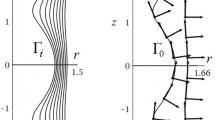Summary
In this paper we repeat the compatibility equations for steady gas flows, given by Ratip Berker, and then we apply these equations to general axisymmetric and plane steady gas flows. We obtain a linear partial differential equation satisfied by the velocity field. Then we find the solutions of some special problems in the cases of plane and axisymmetric flow.
We use the following notation: \(\vec V\) velocity; \(\vec V = V(\alpha ,\beta )\vec e_1 ;{\text{ }}V = g(\beta )G(\alpha ,\beta );\) \(\vec a\) acceleration; \(\vec f\) external force; \(\vartheta \equiv {\text{div }}\vec V,\) \(\vec j \equiv \vec a - \vec f;\) \(\mu = \vec V \cdot \vec j;\) p pressure; q density; s specific entropy; β=const. streamlines; α=const, their orthogonal trajectories; \(ds^2 = h_1^2 d\alpha ^2 + h_2^2 d\beta ^2 \) the element of arc length; w1≡ 1/h1, w2≡ 1/h2
In § 1 we give the compatibility equations for gases.
In the § 2 we consider general axisymmetric flows. We suppose that the streamlines and their orthogonal trajectories are given by the following equations: α (r, z)=const. (orthogonal trajectories), β (r, z)=const. (streamlines) and that the element of arc is of the form \(ds^2 = h_1^2 d\alpha ^2 + h_2^2 d\beta ^2 \) here we put w 1=1/h1 and w 2=1/h2 Writing out the compatibility equations, we obtain the following results for the scalar velocity V: V=g(β)·G(α,β) where g (β) is an arbitrary function of β and G (α,β) is a function satisfying the equation
=0.
In the case of plane flow, r is to be replaced by 1 in this equation. We give expressions for the density, pressure and Mach number in § 3.
In § 4 we give the results for the cases for which the gas is a Prim gas or a perfect gas. The results for plane flows are given in § 5.
In §§ 6–9 we apply the results obtained in §§ 1–5 to some special problems. In § 6 we obtain the solution for axisymmetric radial flow; in § 7, axisymmetric radial flow from an axis; in § 8, plane radial flow and finally, in § 9, flow in concentric circles in the meridional planes in the case of axisymmetric flow.
Similar content being viewed by others
References
Berker, R., Sur les équations de compatibilité relatives au mouvement d'un gaz. Comptes Rendus de l'Académie des Sciences de Paris 242, 342–344 (1956).
Özoklav, H., Flow of a compressible fluid in a hyperbolic channel. J. Math. Mech. 8, 27–46 (1959).
Özoklav, H., Some exact solutions for rotational gas flows. Istanbul 1956.
Mises, R. von, Mathematical Theory of Compressible Fluid Flow, pp. 73–77. New York: Academic Press 1958.
Vinokur, M., Kinematic formulation of rotational gas flow. J. of Fluid Mechanics 9, 533–542 (1960).
Author information
Authors and Affiliations
Additional information
Communicated by R. Berker
Rights and permissions
About this article
Cite this article
Özoklav, H. On rotational gas flows. Arch. Rational Mech. Anal. 15, 154–168 (1964). https://doi.org/10.1007/BF00249523
Received:
Issue Date:
DOI: https://doi.org/10.1007/BF00249523



